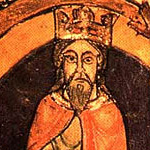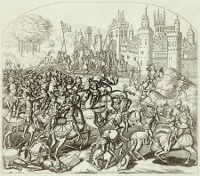King David I of Scotland
King David I of Scotland was a strong, visionary ruler whose power and prestige rivaled that of the English Crown.Scotland's King Edgar died in 1107. Succeeding him was his brother, Alexander I. Alexander married a daughter of Henry I but died childless in 1124, giving way to his brother, David I, the Prince of the Cumbrians. David was on the throne of Scotland for 29 years. David was Malcolm Canmore's youngest son, and his father sent David and his sister, Maud, at an early age to the English court of King William Rufus. When that king died, his oldest son, Henry, succeeded him and promptly married Maud (who was called Matilda in England). In all, David spent 30 years at the English court. 
David was a powerful, expansion-minded king who rivaled the English Crown for influence at this time. He married Matilda of Huntingdon in 1113, giving him control of more territories. A friend of his brother-in-law, King Henry I, he asked for that king's support when a number of disaffected Scots rose up against him. David eventually gained control and ruled with a strong hand thereafter. David had honored Henry's wish of successor, the Empress Matilda and supported her in her struggle against her rival, Stephen. At this time of civil war, known in England as The Anarchy, David took full advantage of the full situation and gained valuable territory and riches. 
Right after Stephen was crowned, in 1135, David invaded England at the head of a large force. He made great headway but, after meeting with Stephen, agreed to avoid direct conflict. The truce didn't last, and David invaded again, and then again, each time avoiding fighting Stephen directly. After the third invasion, David did not again turn north but instead remained to a little harrying of his own. On June 10, 1138, the Scottish army routed the English army at the Battle of Clitheroe. Emboldened, David carried on, meeting the English again in August in the Battle of the Standard, near Northallerton, in North Yorkshire. The result this time was an English victory. The main Scottish force was still in northern England for a few more months. It was Stephen's wife, Matilda, who negotiated the terms of the truce that ended the fighting, in 1139. In the Treaty of Durham, England agreed that David was ruler of Northumbria. As before, though, a change in circumstances brought about a change in direction. When the Empress Matilda arrived back in England at the head of a large force, David joined in the fray, on her side. He was was at Westminster Abbey for what was expected to be her coronation. Stephen and his army had other plans, and Matilda never arrived. David returned to the north. 
David was an economic visionary. The first Scottish king to issue his own coins, adorned by his portrait, and founded more than a dozen burghs, or towns, among them Edinburg, Perth, and Stirling. He transported a successful model of proto-feudalism from Cumbria into wider Scotland and added castles, knights, and royal officials such as sheriffs to oversee the running of the enterprise. In this way, the government of Scotland came more to resemble that of Norman England. He was also a friend to the church. While Prince of Cumbria, he founded Selkirk Abbey. He founded more than a dozen abbeys, including the famous Holyrood Abbey and Melrose Abbey, during this reign. Among the results was a new form of agricultural labor, which resulted in the growth of the wool trade. His only son, Henry, was his intended successor. However, Henry died in 1152. David saw to it that his grandson was named heir to the throne. When David I died, his grandson became King Malcolm IV. See also Early Medieval Scottish rulers. |
|
Social Studies for Kids
copyright 2002–2026
David White




